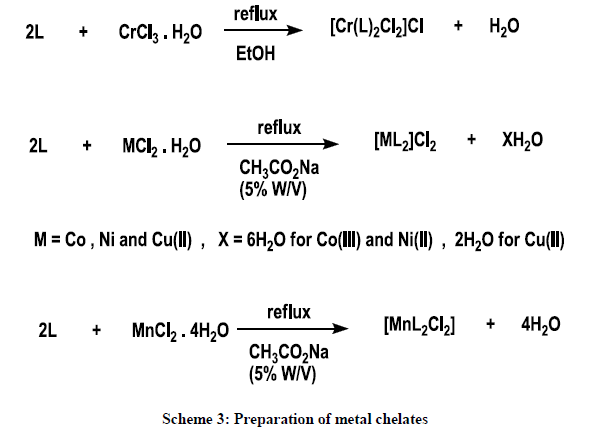Research Article - Der Pharma Chemica ( 2017) Volume 9, Issue 4
Synthesis and Spectroscopic Studies of Novel Transition Metal Complexes with 5-Phenyl-2-[2-Hydroxy pyridylacethydrazide]-1,3,4-Oxadiazole
Adil A Awad*Adil A Awad, Department of Chemistry, College of Science, Al-Mustansirya University, Baghdad, Iraq, Email: aadilaawad@mail.com
Abstract
A new Schiff base 5-Phenyl-2-[2-hydroxy benzylhydrizido]-1,2,4-oxadiazole (HL) and its complexes with (Cr(III), Mn (II), Ni (II), Co(II) and Cu (II) were synthesized. The ligand was prepared in two steps, in the first step a solution of 2- mercapto -5-phenyl-1,3,4–oxadiazole in methanol reacts with 98% hydrated hydrazine under reflux to give an intermediate compound 2-hydrazion-5-phenyl-1,3,4-oxadiazole which reacts in the second step with o-hydroxybenzaldehyde to give the mentioned ligand (HL). The complexes were synthesized by addition the corresponding metal chloride solution to solution of ligand in methanol under reflux (1:2) metal to ligand ratio. On the basis of molar conductance, magnetic susceptibility, I.R, UV–visible spectra and elemental analysis (C.H.N) the complexes may be formulated as [CrL2(H2O2]Cl and [ML2], where M: (Mn(II), Co(II), Ni(II) and Cu(II). The data suggested an octahedral geometry for Cr(III) complex and a square planar for Co(II), Ni(II) and Cu(II), while the Mn(II) complex was tetrahedral.
Keywords
Novel transition, 1,3,4-oxadiazole, Metal complexes
Introduction
Transition metals play a central role in the construction of molecular materials, which display magnetic properties and find application and supra molecular chemistry and biochemistry [1-4]. Transition metal complexes of 1,3,4-oxadiazole derivatives are well known for their biological importance as well as their anticarcinogenic antibacterial and antifungal properties [5]. There are numerous M(II) complexes, which have been well characterized, providing a fertile set of model small molecule oxidant for inquiry. Cr(II), Mn (II) and V (IV) complexes with Schiff base of 1,3,4-oxadiazole ligands can increase the activity of insulin by binding to a small chromium, manganese and vanadyl binding protein [6] the amino group in Schiff bases can from stable complexes with transition metal ion Co (II), Ni(II) and Cu(II) when benzene ring carries an electron donating groups as CH2OH,-OH in the ortho position. In this paper the synthesis and characterization of new ligand 5-phenyl-2-[2- pyridylacethydrizido]-1,3,4-oxadiazole and its complexes with Cr(III), Mn(II), Co(II), Ni(II) and Cu(II) metal ions is reported.
Materials and Instrumentation
All chemicals used in the present investigation were of AR grade, purchased from Sigma chemical Co., USA. Elemental analysis (CHN) of these complexes was carried out on a Carlo-Erba 1106 Elemental Analyzer. Infra-red spectrophotometer, the electronic spectra of complexes solution in DMF were done on Variu-100C UV-Visible spectrophotometer. Magnetic susceptibility measurements were per formed on Gouy-Balance at 30°C using CuSO4.5H2O as calibrant. Molar conductance was measured on ELICO conductivity bridge (Type CM82T).
Preparation of the Schiff base (HL)
Preparation 2-hydrazion-5-phenyl-1,3,4-oxadiazole this derivative is prepared by the method reported earlier, this is shown in Scheme 1.

Preparation of the ligand (L)
A solution of 2-hydrezion-5-phenyl-1,3,4-oxadiazole (1) 1.76 g (0.01 mol) in 35 ml methanol was added to a stirred solution of 2-acetyl pyridine 1.35 g (0.01 mol) in dry benzene (20 ml). The resultant solution was refluxed for about 5 h and then left undisturbed at room temperature. Upon standing pale yellow crystals of (L) formed over a period of 30 h. The crystals of the ligand were collected by filtration, washed with diethyl ether, toluene and dried in desiccator over MgSO4 (Scheme 2).

Preparation of metal complexes
Absolution of CrCl3.6H2O, 0.267 g (1 mmol) in 20 ml ethanol was refluxed with an ethanolic solution of the Schiff base (L) 0.558 g (2 mmol) in 20 ml ethanol for 3 h. The solution was then reduced to on third on a water bath. The green solid complex precipitated was filtered washed thoroughly with ethanol and dried in vacuum. The Co(11), Ni(11), Mn(11) and Cu(11) complexes was prepared by the same procedure but in the ration of 1:1 for Mn(11) complexes and in presence of 5 ml of 5% aqueous sodium acetate solution (Scheme 3).

Conclusion
We have synthesized Cr(III), Mn(II), Co(II), Ni(II) and Cu(II) complexes using Schiff base formed by the condensation of 5-phenyl-2- hydrazino-1,3,4-oxadiazole and 2-acetyl pyridine. The ligand 5-phenyl-2-[2-pyridylacetylhydrazido]-1,3,4-oxadiazole behaved as neutral bidentate reagent to establish six-coordinated Cr(III) complex, and four –coordinated Mn(II), Co(II), Ni(II) and Cu(II) complex. According to the results obtained from elemental analysis, spectroscopic measurements and magnetic susceptibilities, the proposed structures of the prepared complexes were shown as follows:
References
[1] D.R. Fenton, H. Okawa H, TAI press: London, 1993.
[2] N.H. Pilkington, R. Robson, Aust. J. Chem., 1970, 23, 225.
[3] E.A.M. Othman, Baghdad University, 1990.
[4] F.H. Musa, H.A. Al-Bayati, E.A.W. Othman, Ibn Al-Haitham, Pure. Appl. Sci., 1992, 39, 3.
[5] Z.M. Eldeen, K. Sl-Obaidi K., M. Nadir, V.F, Roche, Eur. J. Med. Chem., 199, 6, 272.
[6] E. Mediej, O. Mørsted, P. Kita, J. Chem. Soc. Dalton. Trans., 2002, 2361.
[7] A.R. Levana, C.T. Codd, P.A. Dilon, Lay, Prog. Inorg. Chem., 2005, 51, 144.
[8] R.A. Anderson, J. Am. Coll. Nutr., 2002, 17, 548.
[9] A. Yamamoto, O. Wada, T. Ono, J. Inorg. Bio. Chem., 1998, 91, 22.
[10] G. Rama Raoikmogiliah, B. Screeish, Indian. J. Chem., 1996, 35, 339.
[11] A. Ferary, Z. turgant, O. Ñuktet turk. J. Chem., 2002, 26, 159.
[12] S.M. Annigeri, A.D. Nick, V.K. Mohale, Trans. Mat. Chem., 2004, 27, 316.
[13] B.H.M. Mruthyunia Wana, B.I. Okmer, Y. Jadegoud, J. Brax. Chem. Soc., 2005, 16(4), 789.
[14] K. Nekamoto, 1986.
[15] H. Adams, N.A. Baily, D.E. Tenton, I.G. Ford, S.J. Kitchen, L.F. Lindoy, J. Chem. Sco. Dalt. Trans., 1965.
[16] A.B.D. Lever, New York, USA, 1968.
[17] D.N. Satyanarayna, Universities Press: Hydeabad, India, 2001.
[18] A. Koji, K. MAtsufji, M. Okaw, Inorg. Chem., 2002, 41, 4461.
[19] B.B. Mohapatra, S.K. Saraf, J. Indian Chem. Soc., 2003, 80, 696.
[20] A. Eurnshaw, Academic Press: London, 1968.
[21] R.G. Pearson, J. Am. Chem. Soc., 1963, 85, 3533.



